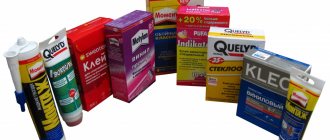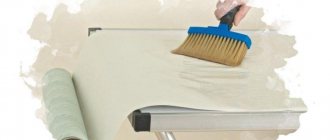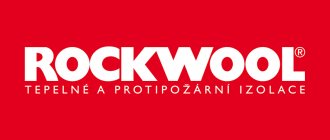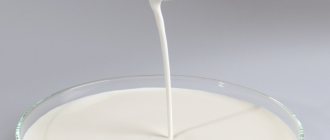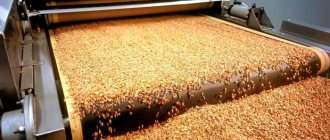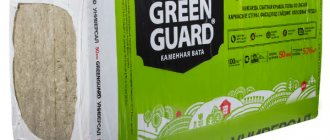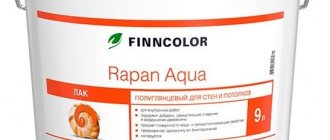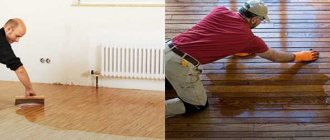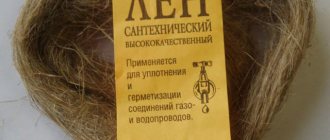PVA glue is considered a universal product that is used for gluing products made of various materials. This adhesive composition is popular due to its low cost and ease of use. Before using PVA, you need to understand its main features.
Composition and technical properties
It is necessary to find out a detailed description of such an adhesive composition and familiarize yourself with its technical characteristics.
PVA glue was created by the famous German scientist Fritz Klatt back in 1912. However, it began to be produced on a commercial scale only a few years later. Today, this adhesive is considered the most popular product used by many people.
To find out the characteristics of adhesives and their features, you need to familiarize yourself with the list of components that are included in the composition. When making glue, polyvinyl acetate is used, which consists of synthetic fibers and vinalone. Plasticizers are added to some types of compositions, which make them more frost-resistant and more plastic. Essential oils, tricresyl phosphate and diisobutyl phthalate are used as plasticizers.
PVA has the following technical characteristics:
- long shelf life of the adhesive solution, which is 5-6 months;
- resistance to low temperatures;
- quick drying;
- adhesive capacity of 400 N/m.
Scope of application
Before using PVA, you need to figure out where it can be used. Some people believe that the adhesive solution is used only for gluing paper, but this is not true. The composition is popular among furniture manufacturers. Special types of carpentry glue are produced that can be used to fasten wooden furniture.
When using such adhesives, a dense film is formed on the treated surface, which reliably glues the wood.
PVA is also used in the construction industry. Many builders add it to cement, plaster and primer mortars to increase their durability and strength. In addition, the product is used in the textile industry to improve the strength properties of fabric products. To make the fabric stronger, place it in a PVA solution for 10-20 minutes.
Varieties of PVA, characteristics, instructions for use
There are various types of PVA, which differ in technical characteristics.
PVA construction adhesive
A construction adhesive is an emulsion made from polyvinyl acetate and additional components that increase the thickness of the adhesive. A distinctive feature of this solution is its yellowish tint.
Many people are interested in what construction PVA glues and what it is used for. It is used when laying wooden flooring and gluing vinyl or regular paper wallpaper.
Stationery PVA glue
To glue cardboard and paper products, use a special stationery solution. It is contraindicated to use it in the construction industry, since it is not able to provide reliable and strong adhesion. The stationery adhesive mixture is produced in small bottles with dispensers.
This composition has several features that you should familiarize yourself with:
- long shelf life;
- dries within 2-3 hours;
- washes off easily.
Liquid PVA glue is considered a universal product that is used both in everyday life and in the construction industry. The high density of the composition allows it to be used for gluing linoleum, carpeting, wallpaper, ceramic tiles and metal sheets. When working with heavy products, this product cannot be used, as it will not cope with the load.
We recommend: Universal glue Moment Crystal transparent, 30 ml (120) 873873
This adhesive is characterized by fast setting and a high level of adhesion. During its manufacture, components are added that increase the density of the composition and make it more reliable. This glue perfectly bonds products made from the following materials:
- glass;
- plastic;
- ceramics.
Many people also use PVA-M if they need to glue something to paper. The properties of this superglue allow it to be used in the construction industry.
What is the difference between PVA glue and PVA-M
To figure out which glue is best to use, you need to familiarize yourself with the differences between PVA-M and PVA. The main distinguishing feature of the products is their thickness. PVA-M is thicker, and therefore many people use it during apartment renovations.
PVA-Contact
When working with wood, PVA-Contact is often used, which has good adhesion. Among the advantages of the solution is its resistance to high humidity and sudden temperature changes. When making Contact, plasticizers are added to increase the density of the composition. This glue is used during repairs when gluing photo paper and vinyl wallpaper.
Universal
Before using PVA-Universal, you need to understand what this product is used for. They are used when carrying out internal repair work. This product can glue products made from fabric, cardboard or paper. The universal composition is also added to cement mortars when laying ceramics or tiles.
Main technical characteristics of the glue:
- hardening time after application to the surface - 18-20 hours;
- composition consumption - 100-200 grams per square meter.
Polyvinyl acetate glue
Polyvinyl acetate glue is a product that does not have a pronounced aroma or color. At room temperature the solution is quite thin, but when heated to 50-60 degrees it becomes more elastic. There are several cases in which a polyvinyl acetate mixture is used:
- gluing products made of glass, iron, paper or genuine leather;
- fastening MDF sheets to plastic surfaces;
- gluing wood.
PVA household wallpaper glue
Wallpaper glue is used for gluing wallpaper and gluing other paper-based materials. Using this composition, wallpaper can be attached to wood, concrete and other surfaces that are covered with plaster.
People who have not previously used household PVA are interested in how to use this solution. When using this product, glue is applied only to the paper surface. Walls should not be treated with mortar, as this will deteriorate the quality of adhesion.
PVA superglue
Superglue is most often used when repairing or assembling furniture. The advantages of the composition include its heat resistance, strength, resistance to dampness and ease of use. The shelf life of superglue is 20-25 months. However, if you store it in rooms with temperatures below 1-5 degrees Celsius, the shelf life will be reduced to 10-12 months.
Superglue perfectly glues products made of wood, plastic, glass, cardboard, paper and leather.
Wood glue
When working with wood, various adhesives are used, but the carpentry variety is considered the most suitable. This is an elastic and high-quality glue that is popular among people working with wood. Its advantages include:
- efficiency;
- elasticity;
- resistance to high humidity.
How long does it take for glue to dry?
Determining the exact drying time of PVA is quite difficult, since it depends on several factors:
- Temperature indicators. At room temperature it dries in 5-10 hours. In conditions of low rates, the drying time increases by 2-3 hours.
- Surface cleanliness. If the surface to be treated is not cleaned of dirt or dust, the glue will take a long time to dry.
- Load on the bonding area. The adhesive joint dries faster in a vice or under pressure.
- Surface area. If large parts are being glued, the applied adhesive solution will take longer to dry.
We recommend: B7000 glue: features and applications
Safety precautions at work
Before using PVA, you should familiarize yourself with the safety recommendations:
- Skin protection. Experts recommend using protective rubber gloves that will protect the skin of your hands from glue.
- Ventilation. Many people believe that when working with PVA it is not necessary to ventilate the room, but this is not so. Ventilation is carried out when using any adhesive solution.
- Using auxiliary tools. Adhesive compositions must be applied to the surface to be treated using rollers or special brushes.
Harm and toxicity of products to the body
Is PVA glue harmful? To answer this question, you need to understand the composition of the product. It is made from polyvinyl acetate and ordinary water. As you know, water is not dangerous and therefore cannot harm a person. Polyvinyl acetate is a colorless component that is also harmless to health. Based on this, we can conclude that PVA is safe for humans.
Product analogues
In addition to PVA glue, there are similar products that can be used when gluing various materials.
People often use adhesives E-7000, E-8000 and other similar products. They are suitable for gluing fabrics, wood, plastic, stone, ceramics and glass. Such products are also used in the repair of electronics, shoes and furniture. Their main advantage is considered to be quick setting in 5-10 minutes.
Conclusion
In everyday life and in the construction industry, many people use an adhesive solution such as PVA. This is an ideal product for wallpapering and gluing wooden furniture. Before using it, you need to familiarize yourself with the types of products, their characteristic features and properties.
PVA glue. Its nuances and methods of application
The development of PVA glue occurred more than 100 years ago by German scientists. The composition quickly became in demand among the population. At the moment, it is used in almost every field. It is widespread because it is not harmful to humans and is universal. It is noteworthy that even after many decades, additions to its composition are being made to expand the scope of its use.
Reviews of some formulations
People who regularly use PVA glue leave reviews about it quite often. For example, let’s take the compositions described above – Moment and Expopribor. Consumers see the same advantages and disadvantages in them.
As for the positive aspects, the masters note:
- efficiency;
- resistance to water, mechanical, thermal, ultraviolet influences;
- economical consumption;
- a wide selection of containers in which products are packaged;
- no pungent odor;
- the ability to be used as an independent product or as an element of a building mixture;
- not explosive.
Speaking of cons, consumers tend to only complain about the short shelf life. Otherwise, no negative aspects were found.
Components that make up PVA glue
Chemists developed this product and endowed it with excellent qualities for gluing a wide variety of objects.
The glue is called PVA because it consists almost entirely of polyvinyl acetate. The remaining part of the glue, approximately 5%, may include components such as dibutyl phthalate, esters, water, various plasticizers, and other chemical compounds. The specific set of substances depends on the type of glue.
There are Kulibins who are attempting to create PVA at home. They use starch and flour as the glue base. It must be said that the resulting mass is far from what is called PVA glue.
The main active ingredient of the glue is obtained by polymerizing vinyl acetate monomer. The resulting component does not dissolve in water, but only swells. The situation is similar with oil solutions. PVA adhesive can be used at both negative and positive air temperatures; it does not emit harmful substances and does not pose a threat to humans.
State technical regulations stipulate that PVA must satisfy the following requirements:
- Does not emit an unpleasant odor. If there is a smell, the glue is fake;
- The applied glue has a white, milky, and sometimes yellowish color;
- After drying, the glue leaves a slightly transparent viscous film;
- The applied composition is highly flexible.
The basic composition of the PVA product can be supplemented to suit the specific needs of the end user. For use in construction, thickeners such as talc, chalk and other components are added.
You can increase the water resistance of the composition by adding gasoline, and glycerin gives elasticity to the glue. It is worth remembering that this affects the strength of the applied composition.
The following ingredients are also added:
- Metal inclusions;
- Cellulose;
- Nitro compounds;
- Defoamers and other chemical compounds.
Those manufacturers who produce glue in pencil format make it based on PVP, a special chemical that replaces polyvinyl acetate. The glue turns out to be hard, with high adhesive characteristics.
What to replace
Along with basic information about the adhesive mass, it is advisable to consider what can replace PVA glue made in Russia. This will definitely come in handy for people living abroad. Indeed, in some countries, for example in France, Spain, Italy, there is an excellent selection of compounds for any purpose.
Here are just a few of them:
- Lydiakol.
- Cleopatre Cleocol.
- Pattex colle vinylica universal flex.
In our country, another type of glue intended for a specific purpose is considered an excellent alternative to PVA. For example, if you need to hang wallpaper, you should look for a bottle with the inscription “wallpaper”; on products for joining wooden surfaces it is directly indicated – “for wood”, etc.
For light work (with paper, cardboard, small pieces of wallpaper, etc.), purchasing glue is sometimes not necessary. In this case, PVA is advantageously replaced with paste prepared at home from flour or starch and water.
Pros and cons of PVA
The composition is easy to use, it is applied confidently and does not flow. If the product is thick, it can be diluted with water. However, it is worth remembering that this does not apply to all types of PVA. The drying time of the glue depends on the air temperature. It can reach 1 day. This is not long for an adhesive composition.
Also, the positive qualities of the adhesive include the following:
- Non-toxic to humans, small children can use it;
- It is not necessary to use personal protective equipment when working with glue. It is safe for the skin;
- There is no risk of fire or explosion;
- Not susceptible to damage from external influences;
- High rates of plasticity. A seam made of PVA glue will not burst when stretched;
- The glue can be frozen and thawed several times;
- It is allowed to use the adhesive composition even in rooms with closed windows. It does not emit harmful substances and does not affect the human body;
- PVA consumption at the rate of 100 to 500 grams per square meter;
- Bonding characteristics are at a high level;
- Not exposed to UV rays;
- Suitable for smoothing surfaces with small irregularities;
- Sold in containers of different sizes for the convenience of consumers;
- Used as a base for primers, or as a separate product;
- The dried layer of glue has no effect on the glued object.
If a glue stain appears in an undesirable place, you can wash it off with plain water. Unfortunately, PVA has its downsides. Its shelf life ranges from six months to a year. After the shelf life expires, the glue will become unusable and cannot be restored. Before using PVA, you must read the precautions and its composition, as it may vary depending on the application. Some types of glue require gloves and a mask to work with.
Main types
Depending on the scope of application, there are several types of glue.
Popular types of PVA glue
| Designation | Purpose | Peculiarities |
| Universal glue (PVA-MB) | Used in everyday life. Excellent gluing of different materials, from paper and cardboard to leather, fabric and wood. Can be added to putty, concrete mix or paint | Withstands 6 times freezing/thawing at temperatures down to -20 °C |
| Wallpaper glue | Used for gluing wallpaper on concrete, plastered and other surfaces. Can glue paper products | Withstands 6 times freezing/thawing at temperatures up to +40 °C |
| Stationery (PVA-K) | Used in educational institutions, offices and everyday life for gluing paper, cardboard | Produced in small volumes for long-term storage and use |
| Super PVA (PVA-M) | Effective in the professional field for gluing tiles, working with laminate, parquet boards, suitable for gluing furniture and fixing mirrors | Does not lose properties in the temperature range from -40 to +50 °C |
| PVA wood glue | Used for gluing wooden products, including furniture, in different environmental conditions: D1 - with a humidity of at least 15% and a temperature of maximum 50 ° C; D2 - with a maximum humidity of 18% and short-term exposure to moisture; D3 - outdoors, short-term exposure to water is allowed; D4 - indoors and outdoors, withstands prolonged exposure to moisture | High moisture resistance |
| PVA dispersion D51S, D51V - unplasticized (frost-resistant) DE51/10S, DF51/15V - plasticized (unresistant to frost) | Widely used in industry in the production of paper, fabrics, packaging, cigarette filters, etc. Added to mortars for better adhesion to the surface, increasing ductility and strength of the connection. | Has increased binding ability |
Scope of use
PVA glue is most widely used in the children's creative sector. It is used in children's institutions, various clubs, and creative schools. A child can use glue without using special protective equipment. If glue gets on your clothes, you can remove it by simply washing the items in the washing machine. The glue is suitable for working with cardboard, paper, thread and other materials. It is interesting to use glue as an attribute for drawing. It can be mixed with paints and applied to canvas. The finished drawing will not fade and will last longer.
PVA has also found its use in construction work. They can be used for gluing wallpaper or as an adhesive base for laminate flooring or tiles. Wood can also be treated with glue to ensure its moisture resistance.
You can add a small amount of glue to the cement. 5% glue is enough for the solution to obtain increased waterproofing properties. When preparing the plaster solution, add universal PVA glue to the main volume at the rate of 70 g. for 10 liters of the main mixture. Thus, the finished solution is better applied and adheres more firmly to the surface.
Production technology
OGRN – 1047796379080
Anyone can make a composition if they go through the following steps:
- Preparation of raw materials.
- Adding specific components.
- Selecting the required proportions, then determining the weight.
- All ingredients are processed.
- They cook.
- They insist.
- Distribute technical and other glues into portions and place them in packaging.
The types of equipment used include packaging materials, dissolvers, mortar mixers, and so on. They can only manually place raw materials into certain tanks.
The kneading procedure can be complicated due to the high viscosity of the composition. But only beginning manufacturers encounter problems; over time, they get rid of any troubles. PVA glue decoding also helps to understand how to proceed.
GOST PVA glue
Each buyer can and even should familiarize themselves with the state standards that apply to these products. Then there will be more confidence that the money is not wasted. And that the composition is capable of performing its function.
According to GOST, the specified universal PVA glue has the number 18992-80 or 18992-97.
PVA glue properties after drying
The dry state of the glue is one of the main characteristics of this substance. From this, among other things, you can determine the overall quality. Optimally, when all properties are preserved in full, a transparent film of increased viscosity appears on the surface. Such elements are easy to notice during any inspection; due to this film, the materials are held together. This is an important characteristic.
But it is impossible to give a definite answer to the question of how long it takes PVA to dry. On average, this process takes about a day.
Manufacturers also provide information on this issue in the instructions. Often everything depends not only on the initial properties of the material, but also on the total number of layers, the temperature of the room and hair dryer, the area of smearing, and the area of application. Whether the material is waterproof or not doesn't matter.
Container and packaging
On counters, PVA glue is found in the following containers that can be used equally:
- Tubes.
- Banks.
- Buckets.
These are usually plastic-based devices. The tubes have special spouts. In the case of buckets or cans, you will need to buy an additional tool to make it easier to distribute the mixtures over the surface. They can consist of different materials.
PVA for domestic use
PVA glue is widely used for wallpapering, especially heavy wallpaper. These include non-woven wallpaper, photographs, and fabric compositions. Works great on drywall, concrete surfaces, brick and plaster bases. Excellent gluing of cardboard, paper products, foam compositions. It is relatively thick, white, milky or yellowish. It can be frozen and stored at low temperatures. After defrosting, the glue will not lose its qualities. After the composition expires, it will split into liquid with white flakes. This composition cannot be used.
The form of glue packaging is bottles, buckets or jars.
There are a number of the most popular brands:
- Amotex;
- Big;
- Profilux and a number of others.
PVA adhesive for office use
The letter “K” is added to the designation of this glue. Its composition is almost identical to household glue. It can also be combined to create various kinds of compositions from cardboard, multi-colored paper and fabric. The manufacturer offers it in the form of bottles with a volume of 50 to 250 grams, as well as in the form of an adhesive stick. It is important that the pencil has good contact with the surface. To do this, add a small proportion of glycerin to the dry composition.
Office glue is represented by many manufacturers, including:
- Ray;
- Ribbon;
- Centrum;
- Delhi;
- Bik and others.
The most reliable and high-quality composition is Elmers, made in America. Everyone is familiar with toys in the shape of slimes. This glue is one of the components of this toy. It is mixed with sodium tetraborate. You can find recipes on the Internet on how to make these unusual toys at home. It is necessary to mix sodium tetraborate and PVA glue in equal proportions. Currently, counterfeits of this composition are appearing. It is important to check the barcode, which can be used to recognize the country of manufacture. This way you can avoid purchasing low-quality goods.
Manufactured in Russia, famous brands
The number of PVA glue manufacturers in Russia is not as large as it might seem at first glance. But consumers are quite satisfied with the range of products they present on the market.
The most popular adhesives today are Expopribor and Moment. They are sold at competitive prices, but each product has its own distinctive features. They are described in more detail below.
PVA glue Expopribor
The popular PVA roller glue from Expopribor belongs to the premium class. It is intended for work with paper, cardboard, wood, fabric, leather and ceramics when thin and neat seams are required. This product is easy to use, economical in use and does not pose a threat to human health, since it contains no toxins.
The glue is sold in standard packages with a ball applicator, due to which the layer is always distributed evenly. A spring-loaded ball made of stainless steel serves to protect against leakage of the mass in any position of the packaging.
Glue Moment PVA
The adhesive mass is available in different versions - for paper and cardboard, with protection from moisture, for working with wood, leather and other materials. The name of the glue speaks for itself - it bonds surfaces instantly. But you shouldn’t take this too literally, since it still takes some time for it to dry and, at the same time, reliably connect objects.
Many consumers conduct various experiments with PVA Moment glue, adding it to building mixtures. The result, oddly enough, is often pleasantly surprising, although unsuccessful experiments also occur in practice. The product is packaged in small tubes, buckets and containers. Therefore, if necessary, you can easily find a convenient option for yourself.
PVA product for universal use
When purchasing this glue, you need to pay attention to its labeling. It must contain the designation MB. In addition to cardboard and paper, they can be used to glue leather and glass. We can also use glue for gluing carpet to the base, as well as linoleum. When preparing mortars based on a water-dispersion composition, PVA-MB is often added. The maximum negative temperature of use is minus 20 degrees Celsius.
The product PVA-M is sold on store shelves. It differs significantly in price to a lesser extent, however, its quality is not high.
It should only be used on cardboard and paper. Among the manufacturers of universal adhesives are:
- Tex Universal;
- PVA-801;
- Omega;
- Navigator and others.
PVA Super Glue
During the production of this glue, components are added that greatly enhance the properties of the glue after it dries. The special formula in superglue allows it to be used even when laying tiles, as well as wallpapering. If you need to cover a small area of the floor, this glue is indispensable. It also smoothes out surface unevenness. The glue is resistant to contact with moisture. Since the composition is frost-resistant, it can be used even outdoors or in rooms without heating.
Common brands:
- White House;
- Novokhim;
- Akron and others.
Factors affecting drying time
Often buyers are interested in increasing the drying time of PVA. It can reach 24 hours if the room temperature is low enough. If the area is large or the seam is too thick, it also takes more time.
The following tips can help you get the results you want faster:
- High-quality surface preparation, including not only removing dust and dirt, but also degreasing.
- Use a roller rather than a brush. Then the layers become thinner.
- Maintaining tight compression of surfaces with each other.
- Moderate increase in temperature, including with construction or household hair dryers.
PVA for construction work
Not all adhesive compositions can cope with use in a cold room. A professional adhesive composition has been developed especially for temperature changes. It is offered in the form of an emulsion with special polymerizing inclusions. A small amount of PVA construction adhesive is added during the preparation of mortars. The resulting mixture can be used when working with tiles, bricks and concrete.
A separate category of construction glue is wood glue. It is used only for working on wood, chipboard, plywood and other types of wood materials. Joiner's PVA is also used for gluing and producing furniture and other wooden structures.
You can tell if the glue is moisture resistant by looking at the markings. There should be the letter D, as well as one of the numbers, from one to 4, this is the moisture resistance class.
Construction adhesives can be used outdoors. They can withstand temperatures down to -40 degrees Celsius. Positive qualities include low product consumption, ultraviolet resistance, high strength, and a quick-drying composition.
Common brands of construction PVA include:
- Tex;
- Moment;
- Contact and others.
Nuances on which the glue drying time depends
There are situations when it is necessary for PVA to dry faster. When the room temperature is low, it can dry for almost 24 hours. The long drying time is due to the large coverage of the glue, as well as its application in a thick layer. If you glue together plain paper, then everything will be ready in 20 minutes.
To make the glue dry faster, it is important to follow a number of rules:
- Prepare the surface for applying glue in advance. It must be clean, dry and grease-free;
- For a thinner application layer it is necessary to use a roller. If you glue with a brush, the layer of composition will be large;
- The two glued materials must be kept under pressure for some time, that is, something heavy must be placed in place of the gluing;
- You can increase the temperature by heating the glued area with a hairdryer, or by holding the glued area in the microwave for a short time;
- When heating the glued area, it is important to maintain the temperature. In the range from +100 to +200 degrees Celsius, the adhesive will break down.
Explanation and technical specifications
PVA glue (interpretation) – polyvinyl acetate (PVA). The three-letter abbreviation comes from this component, since the adhesive mass contains about 95% of it.
In accordance with the state standard, PVA glue technical characteristics should be as follows:
- resistance to moisture, temperature changes;
- drying time on surfaces – on average 24 hours;
- load – 550 N/m;
- absence of a pronounced specific odor;
- color – uniform;
- elastic seam.
Other characteristics are listed below. They are worth considering in more detail, since these are the points that characterize such a composition as PVA. Moisture resistance is indicated by the index D1…D4.
The higher the number, the stronger the moisture resistance. Very important for carpentry work.
Situations in which the glue needs to be diluted
If the glue becomes too thick, it can be diluted with plain water. Water must be added in small portions so that the glue does not become too liquid. Water will not make the glue more brittle or durable.
It is important to remember that construction and professional PVA adhesives must not be mixed with water. Otherwise it won't stick together. As a rule, construction PVA can be diluted with acetone. The label may also indicate other dilution methods.
A thinner glue will be applied to the surface much more economically. Another reason for diluting PVA is the process of preparing a solution for priming the surface. The proportions should be as follows: 5 parts water mixed with 1 part glue. Sometimes the glue needs to thicken. This can be achieved by leaving the jar open for 24 hours. Unnecessary moisture will leave the jar.
Instructions for working with glue
For each PVA glue, the instructions for use are simple and clear. When unpacking the composition, you should be sure to read the insert inside, which talks about the use of this particular type of adhesive. If instructions are not provided in the kit, it is better to work with PVA according to standard rules:
- The surfaces to be glued must be cleaned of dirt and dried before applying the adhesive.
- The mass is distributed with a brush or, in rare cases, with a spatula with teeth.
- The composition should be applied evenly and not too thickly.
- The second layer, if required, may be applied only after the previous one has dried.
- It is better to press the parts to be glued tightly against each other and hold for several minutes.
Temperature of storage, work with PVA and operation
It is also important to consider the rules for storing and using PVA glue. The temperature at which this composition is used cannot fall below -20 degrees Celsius. The maximum indicator is considered to be +100 degrees - in this case the mass begins to collapse. The same applies to the storage of PVA.
The glue can be used both indoors and outdoors. Since it is moisture resistant, it is allowed to work with the product during precipitation (not heavy), without fear of deterioration in the properties and quality of the result.
How long does it take to dry?
Among other things, every consumer needs to know how long PVA glue takes to dry. This period of time is different for each purpose of using the composition. So, when joining the paper, 15 minutes is enough for complete drying. If construction and repair work is carried out with glue, the average drying time is 1 day.
It is important to remember that a thin layer of adhesive dries much faster. Therefore, it is better to distribute the product evenly using special devices. In addition, to speed up the drying of the PVA, you can use a hairdryer or microwave to increase the temperature.
How to dilute PVA glue
People often ask whether PVA glue can be diluted with water, because this component is ideal for solving the problem of a thickened composition. In some cases this is allowed. The most important thing is to add liquid literally gram by gram.
This ingredient does not impair the properties of household and office glue. But for other types of PVA, it is worth using acetone as a diluting component, because water in any form contributes to the loss of their adhesive function.
How to thicken PVA glue
Along with methods of diluting the composition, craftsmen are also interested in how to make PVA glue thick. Here things are simpler.
To thicken the mass, simply leave it in an open container for a day.
During the specified period of time, excess moisture will evaporate and the mixture will become ready for use.
Rules for using the adhesive composition
To ensure a strong connection of materials, it is recommended to follow simple rules:
- The product must be thoroughly mixed before applying;
- The air temperature in the room should not be lower than +10 degrees Celsius with a humidity of no more than 80%;
- The surface must be prepared and cleaned;
- The base on which the glue is applied must be dry;
- Cover only one of the parts necessary for gluing with glue;
- The adhesive layer should not exceed 2 millimeters;
- Minimize external contact with the glued area until completely dry.
PVA glue has a low price and high strength of glued parts. It occupies a leading position among buyers due to its reliability and environmental friendliness.
Imported analogues
Products with similar properties and functions are also produced abroad. At the same time, their overall quality is in no way inferior to Russian developments.
Korean pva glue leeho
Produced in South Korea, available in 28 ml with two dispensers. The connecting properties of this composition are quite good; it always fits well onto the surface being treated. At the same time, you don’t have to worry about the formation of foam or lumps. Drying takes minimal time.
